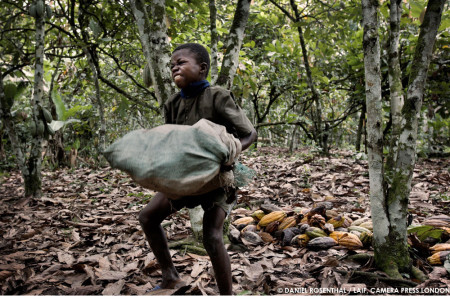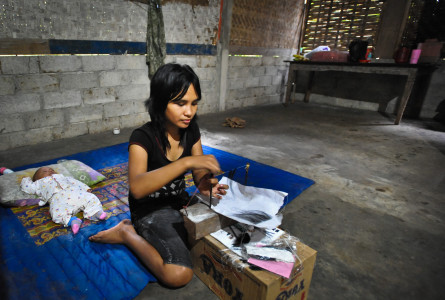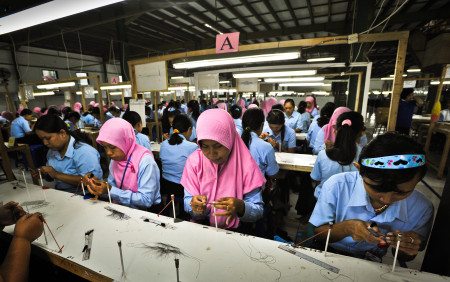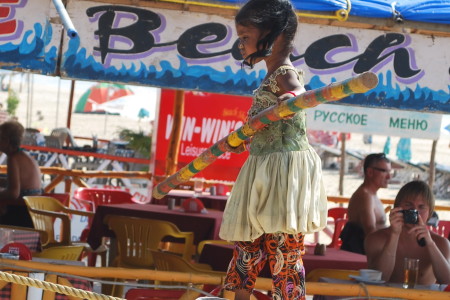About this Collection
What do I want to find out?
To what extent pupils understand their potential power as consumers and as agents for change – individually or as part of a bigger group; whether they consider the consequences of their actions and whether they are motivated enough by injustice to take action.
What do I need?
- A photo of the producer of a product that the pupils consume e.g. Jean Baptiste harvesting cocoa pods, or the Indonesian eyelash workers.
- Cards with choices for action – one set for each group.
- A sheet of sticky dots.
Nine year old Jean Baptiste carrying sacks of cocoa pods weighing approx 30 kg on his father’s plantation on the outskirts of the village Sinikosson, Cote d’Ivoire. He doesn’t attend school; work begins at 8.00am and involves cutting fruit off the trees with a machete and removing the beans. The family has no other source of income. Jean Baptiste has no idea what happens to the beans.
Choices for action cards: Cocoa
|
Sponsor a child |
Nothing I can do will make a difference |
|
Ask my local shop to stock more Fair Trade chocolate |
Buy Fair Trade chocolate more often |
|
Participate in the Send My Friend to School campaign for free primary education for all children |
Write to a chocolate company saying I want them to use only Fair Trade cocoa and sugar |
|
Join an organisation campaigning against slavery |
Persuade my school to become a Fair Trade school, or your town to become a Fair Trade town |
|
Convince other people I know to take action too |
Stop eating chocolate |
|
It’s not my responsibility to make a difference |
Something else |
Alternatives and adaptations
Fake eyelashes
Caption
These women in Indonesia make false eyelashes for the European and US markets. Some women work in factories where they can earn about 4p per pair, others like Friti aged 20, are homeworkers, juggling child care and work, and earning about 1p per pair.
Child entertainers
Caption
This 3 year old girl, is the sole earner in her family, entertaining tourists at a beach café in Goa. Her younger sister is being trained up to take over when she is ‘too old’; at around 5-6years she won’t be appealing enough to earn money.
It raises questions about responses to child labour – children working in family businesses, child entertainers (e.g. Shirley Temple), the right to play and to education, at what age should children be permitted to work, the responsibility of the tourists she entertains, the trade union of child labourers campaigning for the right to work (in Bolivia).
What do I do?
Timing: 15 minutes
- With pupils in groups of four or five, show the chosen photograph and caption
- Firstly ask each group to rank the choices for action in response to the question “What would make most difference?”
- Secondly ask the pupils to respond to the question “Which am I most likely to do?” by putting stickers on the cards showing actions they would take (prompts could be: Which can you do on your own? Which can you do with others?) Don’t restrict the number of stickers per pupil and if possible ask a note taker to capture the discussion.
How do I analyse the results?
- Collate the ranking for each choice for action, tally the number of stickers on each. Review any discussion notes.
- Is there evidence from this and from discussions that pupils consider the consequences of their choices for action? For example putting low-paid workers out of a job is unlikely to be the best option for them, whereas sustained lobbying of retailers for better working conditions can have an impact.
- Examine the number of stickers on each action card. Are pupils more likely to take some actions than others? If so discuss with them why this might be and explore possible actions through your teaching.
- Look for evidence that pupils have been motivated to take action already.
- Pupils can research appropriate responses to injustices in the supply chain for a wide range of products, and discover how historical campaigns have made a difference to living and working conditions around the world.
How do I measure the change?
- Repeat the ranking activity using an alternative image and action cards and compare the results.
- As the follow up ask pupils to respond with stickers to the question “What have I done?” (On your own? With others?)
- Look for increased awareness of the consequences of their choices for action on the producer.
- Look for increased willingness to take action in support of social justice.
Featured image by Sue Lyle





